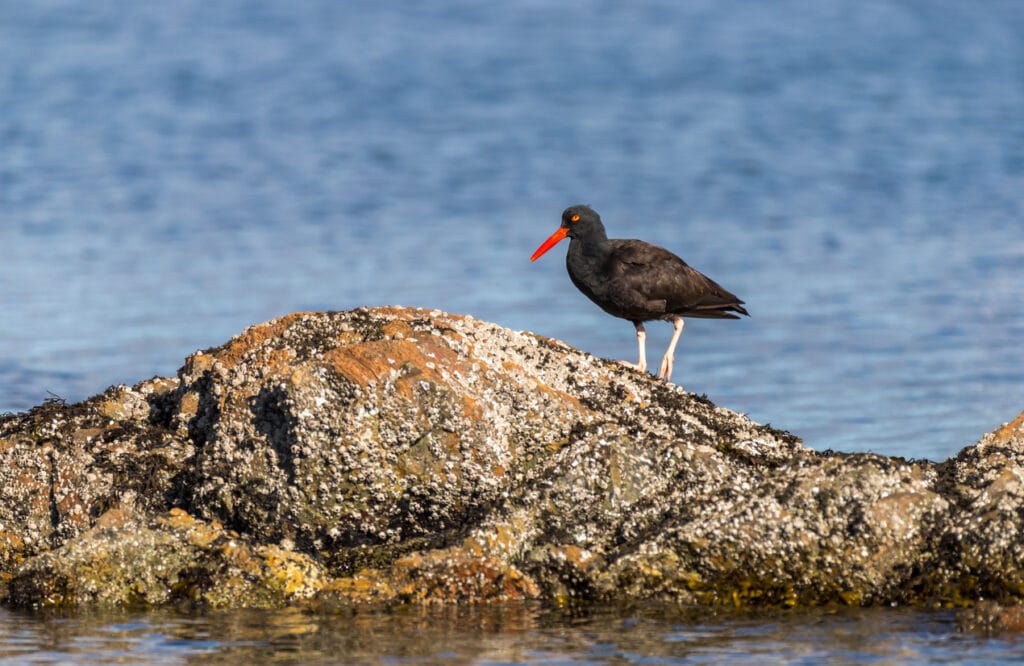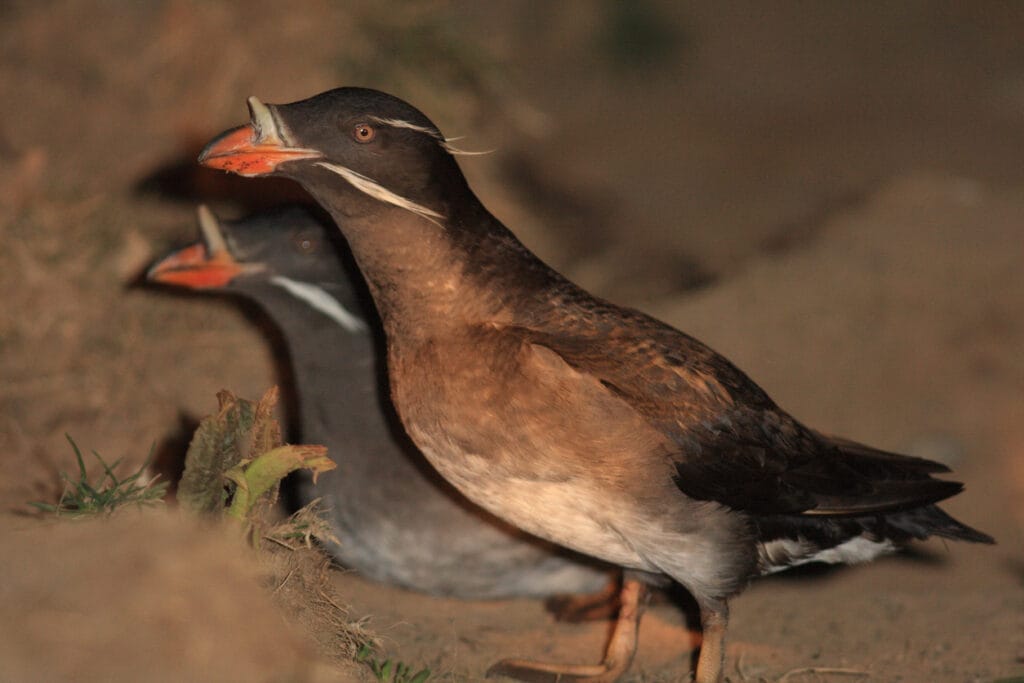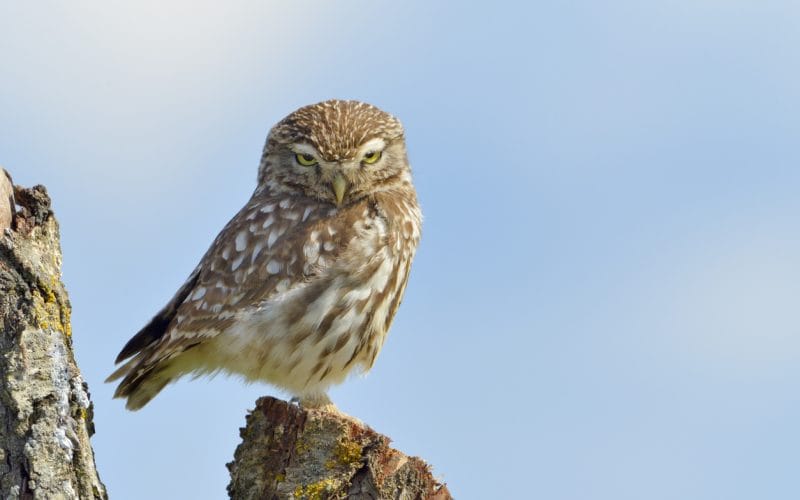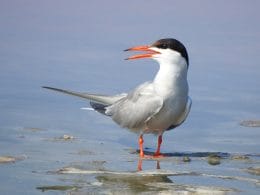The Oregon Coast stretches for about 363 miles, bordered by the Pacific Ocean to the west and the Oregon Coast Range to the east. This region is further subdivided to the North, Central, and South Coast areas that extended from the Columbia River to Oregon’s border with California to the South.
So, if you’re a resident of the Beaver State or currently visiting it, you have a great chance to witness a lot of seabirds and shorebirds that live along the ocean. Keep on reading to learn more about them.
15 Amazing Seabirds to Spot in Oregon
Here are 15 wonderful birds that you might encounter in Oregon.
1. Common Murre

- Scientific name: Uria aalge
- Length: Between 15 and 18 inches
- Weight: Between 1.6 and 2.75 pounds
- Wingspan: Between 24 and 29 inches
The Common Murre is the most widespread seabird in Oregon, nesting in colonies made up of tens of thousands of birds. It’s known for its dark brown above and white belly and has an upright stance. It’s one of the most common Oregon seabirds.
Author Note: Birds fly over the ocean in lines made of up to 40 birds. The wings act like flippers when it dives up to 590 feet to catch fish, squid, octopus, and krill.
Adult birds don’t build nests, and Common Murres’ eggs are extremely narrow on one end and broad on the other. This shape will allow the egg to rotate around itself if pushed instead of falling off the cliff.
2. Leach’s Storm-Petrel

- Scientific name: Hydrobates leucorhous
- Length: Between 7 and 8.2 inches
- Weight: About 1.5 ounces
- Wingspan: Between 16.9 and 18.8 inches
The Leach’s Storm-Petrel is the second most abundant seabird in Oregon, although it’s rarely seen near the shore. During the breeding season, this little bird nests in burrows that are usually concealed by the darkness.
It’s an all-black bird when seen from below, but a closer examination reveals that the back and head are dark brown. It usually comes close to the shore after a storm and feeds on fish, squid, and crustaceans, usually foraging near whales and other marine mammals.
Pairs form strong bonds and mate for several years, as this bird is known to live up to 24 years.
3. Double-Crested Cormorant

- Scientific name: Nannopterum auritum
- Length: Between 28 and 35 inches
- Weight: Between 2.6 and 5.5 pounds
- Wingspan: Between 45 and 48 inches
The Double-Crested Cormorant is the most commonly found cormorant in Oregon. It’s found during spring and summer in both freshwater and saltwater habitats at estuaries, bays, and along the Lower Columbia River and island cliffs.
Adult birds are brownish-black with a patch of orange skin on the face and grow a double crest of stringy feathers during the breeding season. This bird dives and chases fish underwater. It’s another super common Oregon seabird.
Author Note: It also catches amphibians and crustaceans, usually hammering crayfish on the water to shake its legs off and then swallowing it headfirst.
4. Caspian Tern

- Scientific name: Hydroprogne caspia
- Length: Between 19 and 24 inches
- Weight: Between 18.7 and 27.6 ounces
- Wingspan: Between 50 and 57 inches
The Caspian Tern is all white with pale gray upper wings, and the crown turns black during the breeding season. The largest colony of Caspian Terns in Oregon is located in the lower Columbia River Estuary, but it can be found in the summer along the shores of Gold Beach, Waldport, and Coos Bay, in addition to Malheur and Harney lakes in Southeast Oregon.
The world’s largest breeding colony exists on an artificial island in the Columbia River between Oregon and Washington.
Caspian Terns set up their nests on flat sandy or pebbly areas to detect predators. This is the largest tern in the world, and it flies slowly over water, detects its prey, and then dives swiftly to catch fish or crustaceans.
5. Black Oystercatcher

- Scientific name: Haematopus bachmani
- Length: Between 16.5 and 18.5 inches
- Weight: Between 17.6 and 24.7 ounces
- Wingspan: Between 28 and 36 inches
The Black Oystercatcher is a common all-year resident of the rocky shoreline of Oregon and less common along the sandy Central Coast. It’s black-brown with a bright orange compressed bill, pale pink legs, and yellow eyes ringed with red.
It forages on rising and falling tides to pry on blue mussels, clams, sea urchins, crabs, and rarely on oysters despite its name. Unlike other seabirds that prefer rocky cliffs, the Black Oystercatcher is found on flat rocky reefs and shores with gentle slopes. This bird has a loud call, often sent as a territorial warning.
6. American Herring Gull

- Scientific name: Larus smithsonianus
- Length: Between 24 and 26 inches
- Weight: Between 2.31 and 3.64 pounds
- Wingspan: Between 47 and 61 inches
The Herring Gull is pale gray with a white head and underparts, and black wingtips. It’s a winter visitor of Oregon, mostly around Portland and Eugene.
This bird is usually seen patrolling shorelines and the open ocean, usually spiraling around fishing boats, and it also steals food from other seabirds. The Herring Gull feeds on fish, crustaceans, marine insects, other seabirds, in addition to the eggs and nestlings of other gulls.
Author Note: When the Herring Gull catches a clam, it drops it from a height to break it open. During the breeding season, the male feeds the female, losing precious fat deposits during this process.
7. Cassin’s Auklet

- Scientific name: Ptychoramphus aleuticus
- Length: About 9.1 inches
- Weight: Between 5.3 and 7.1 ounces
- Wingspan: About 24.4 inches
The Cassin’s Auklet is dark gray with paler underparts and belly. It’s an all-year resident of Oregon, usually seen on offshore rocks, as it turns to its nesting sites late at night to avoid predators like Western Gulls.
This bird usually digs burrows that are two to six feet deep and is the only Northern Hemisphere seabird that raises two broods in a single season when prey is abundant.
Cassin’s Auklets can dive up to 100 feet, but most dives are less than 50 feet. These birds feed on fish, squid, and crustaceans, usually foraging alone or in pairs.
8. Pelagic Cormorant

- Scientific name: Urile pelagicus
- Length: Between 25 and 35 inches
- Weight: Between 52 and 86 ounces
- Wingspan: About 3.3 feet
The Pelagic Cormorant is a small cormorant with a slender neck, black plumage, a green-purple gloss, and a coral patch of skin on the throat. It’s a year-round resident of Oregon’s rocky coast, and during the breeding season, it’s likely to nest on the cliffs close to coastal roads, so you might see it from your car.
This bird can dive up to 138 feet to catch its prey with its hooked bill. It attacks schooling fish from below and also feeds on marine invertebrates, shrimps, and crabs. When it catches small prey, the Pelagic Cormorant usually swallows it as a whole while it’s still underwater.
9. Long-Billed Curlew

- Scientific name: Numenius americanus
- Length: Between 20 and 26 inches
- Weight: Between 1.08 and 2.09 pounds
- Wingspan: Between 24.5 and 35.5 inches
The Long-Billed Curlew is the largest shorebird in North America. It has a rich buffy brown plumage with a cinnamon wash and a long, curved bill, and it’s commonly found in the Harney/Malheur Lake area and Columbia River Basin.
This bird uses its long bill to dig the ground for marine insects, crustaceans, shrimps, and crabs, and it can usually be seen on tidal mudflats. The female usually abandons the brood a couple of weeks after the eggs hatch, leaving the male to take care of the young.
10. Rhinoceros Auklet

- Scientific name: Cerorhinca monocerata
- Length: Between 11 and 11.4 inches
- Weight: Between 12.3 and 21.9 ounces
- Wingspan: Between 23.2 and 24.4 inches
The Rhinoceros Auklet is a cloudy gray bird with two white plumes on its face, and it gets its name from the pale horn that grows during the breeding season. Goat and Hunter Islands have the largest summer breeding colonies in Oregon, in addition to Sea Lion Caves, south of Cape Perpetua.
The bird’s horn represented a mystery for years, but scientists agree that it’s fluorescent to animals that see ultraviolet light, like the Rhinoceros Auklet. As a result, birds are able to see each other underwater or in their breeding colonies at night.
Rhinoceros Auklets swim underwater to chase schooling fish and drive the prey to the surface. Although they can dive up to 100 feet, they usually prefer to feed at depths less than 30 feet.
11. Tufted Puffin

- Scientific name: Fratercula cirrhata
- Length: About 14 inches
- Weight: About 1.6 pounds
- Wingspan: About 14 inches
The Tufted or Crested Puffin is a stocky bird with black plumage, white face, tangerine bill, and swept-back head plumes. It loses its tufts, and the feathers become darker in winter.
You can spot this bird at Face Rock in Bandon and Haystack Rock in Cannon Beach, as it prefers to burrow on rocky islands with grassy areas. Some burrows can be more than 5 feet deep, providing adequate protection from terrestrial predators.
It flies underwater to catch small fish, and adult birds consume their prey while they’re still underwater. Parents can carry up to 20 fish crosswise to bring them back to the nest.
12. Marbled Murrelet

- Scientific name: Brachyramphus marmoratus
- Length: Between 9.4 and 9.8 inches
- Weight: Between 9.1 and 12.6 ounces
- Wingspan: Between 9.5 and 10 inches
The Marbled Murrelet has a brown above and mottled brown and off-white below, although birds get darker in winter. It nests in coastal coniferous forests, where it prefers to nest up to 150 feet off the ground while feeding all day long along Oregon’s Coastline.
Author Note: It’s listed as a Threatened Species in Oregon, California, and Washington.
This bird prefers to feed at the shore, although some will fly offshore for prey. It uses its bill to catch fish, crustaceans, and zooplankton, usually fishing at dusk and dawn. Adult birds will eat smaller fish than the ones they catch for their young.
13. Pigeon Guillemot

- Scientific name: Cepphus columba
- Length: Between 12 and 15 inches
- Weight: Between 16 and 19 ounces
- Wingspan: Between 21.6 and 23.2 inches
The Pigeon Guillemot prefers to nest on the rocky shores of Oregon for protection from predators. It’s a dark brown bird with a patch of white feathers on its wings. During the breeding season, the red color of the feet and lining of the mouth will get brighter.
It dives underwater, using its slender bill to dig the seafloor for prey. It usually feeds on fish, fish eggs, squid, shrimp, marine worms, and crabs.
Although it can dive up to 138 feet, it usually prefers to feed in shallow waters and not far away from the nest. Unlike puffins, the Pigeon Guillemot will bring one prey at a time back to the nest.
14. Brown Pelican

- Scientific name: Pelecanus occidentalis
- Length: Between 3.25 and 5 feet
- Weight: Between 4.4 to 11 pounds
- Wingspan: Between 6.6 and 7.5 feet
The Brown Pelican visits Oregon in the summer, where it can be easily recognized by its big gray-brown body, yellow head, and massive bill. It can also be seen during spring and fall, but it’s less common.
Brown Pelicans usually join other bird species for feeding on fish schools of anchovies, sardines, herrings, and mullets. The bird plunges into the water, often shocking small fish before scooping them up with its large bill. It usually feeds about 12 miles off the shore.
The bird’s throat pouch expands, trapping as much as 2.6 gallons of water. When it’s draining the water from the bill, gulls usually try to steal some fish. You can also see the Brown Pelican sitting on the water’s surface to catch fish when the water is too shallow for plunging.
15. Brandt’s Cormorant

- Scientific name: Urile penicillatus
- Length: About 34 inches
- Weight: About 4.6 pounds
- Wingspan: About 4 feet
The Brandt’s Cormorant is one of the most common cormorants that you can find in Oregon in summer, usually nesting in colonies along the rocky shores, offshore islands, and mainland cliffs.
The bird’s plumage is all black with a cobalt-blue band on the throat and some whiskery white feathers on the head, neck, and shoulders.
This bird usually feeds in waters that are about 14 miles off the coast, foraging in large flocks with other seabirds. It dives under the water and catches the prey with its strong bill, crushing it and swallowing it headfirst.
Brandt’s Cormorants dive below or beside fish schools, driving fish to the surface for capture. They also hunt squid from depths as far as 230 feet.
In Conclusion
The time you spend in Oregon is an excellent chance to study a lot of birds that live along the shore and on the offshore rocks. Some of these birds are more challenging to see than others, but a pelagic trip will be a great chance to encounter some mixed flocks feeding together.
We hope you enjoyed our guide on Oregon seabirds!
FAQ
The Common Murre nests in huge numbers on the coast of Oregon.
The Western Snowy Plover is the only shorebird to breed along Oregon coasts during the summer months.
The Black Oystercatcher can be regularly seen alone or in pairs on beaches and rocks along the Oregon coast.











What is the bird in the first picture at the top of the article?!?!